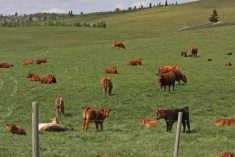CARMAN, Man. – It’s not every day you meet a dog that likes to eat tomatoes. And even more rare is a 260 pound St. Bernard who has a connoisseur’s taste buds for the finest of tomatoes.
“Bernie will go straight to the juiciest and tastiest tomato,” said the St. Bernard’s owner, Jessy Friesen, who added that the dog likes to eat his favourite treat right off the vine.
Luckily for Bernie and his partner Duke, a Newfoundlander, they have the pick of some of the tastiest tomatoes on the planet because the two are watchdogs at Heritage Harvest Seed, a company that specializes in endangered species of vegetables, flowers and herbs.
Read Also

Know what costs are involved in keeping crops in the bin
When you’re looking at full bins and rising calf prices, the human reflex is to hold on and hope for more. That’s not a plan. It’s a bet. Storage has a price tag.
Tanya Stefanec and her boyfriend, Friesen, grow heirloom carrots, squash, beans and tomatoes on their 17 acre farm west of Carman, Man., and sell the seed from those rare varieties to gardeners across North America.
“Our customers are quite varied,” said Stefanec, who grew up in Fisher Branch, Man., and developed a love of horticulture early in life, through gardening with her mother Iris. She then took a degree in horticultural technology at Olds College in Alberta, where she met Friesen.
Some of their seed buyers simply prefer the taste and aroma of an unusual variety, Stefanec said.
“And then there’s the people who are just in it for the history,” she added, explaining that people love to know the stories behind varieties like Canadian Crookneck squash and Russian Saskatchewan tomatoes.
“There are heirlooms that don’t have a clear history. And those ones don’t sell as well.”
To get those stories out, Stefanec and Friesen publish a catalogue with a brief history of their 500 varieties and advertise on internet gardening sites.
After doing it as a hobby for several years, Stefanec and Friesen started Heritage Harvest Seed in 2005. Recently, they were able to quit their day jobs because business is rapidly expanding.
“Every year since we started, our sales have doubled,” said Stefanec, who noted their timing was excellent because the media’s attention to genetically modified crops spawned more interest in preserving seeds.
“Because of the technology, it’s better for our business. And there’s more widespread knowledge of heritage plants.”
Stefanec also attributed the rapid growth to their inventory of rare varieties, such as Queen Anne’s Pocket Melon.
However, building that inventory of rare varieties has taken a great deal of effort. As an example, Stefanec said they recently acquired the seed for a carrot developed in the 1600s.
“This year we’re really excited, we have Early Scarlet Horn carrots… They’re the oldest named variety of carrots available.”
But to harvest the seed from that carrot, Stefanec and Friesen must first grow the variety to ensure that it is true to type, meaning the vegetable matches the descriptions and images in old seed catalogues.
During a walkabout of their farm, Friesen and Stefanec, accompanied by Bernie and Duke, explained the next step of the process.
If the Early Scarlet Horn carrot is true to type, they will grow it again next year and harvest the seeds from the umbel, or flowers, on the carrot stalk.
The rows on their farm are typically 10 to 20 metres apart, which are necessary to prevent cross-pollination.
“For instance, squash have to be separated by a half a mile,” she said.
Over the summer they employ two weed pickers, who come in once a week. And throughout the growing season, Friesen cultivates between the rows with a small garden tractor.
The winter months are also busy because customers buy garden seeds from January to April.
“It’s not only planting. Then it’s growing, then it’s harvesting, then it’s seed cleaning, then it’s packaging and shipping,” Stefanec said.
Despite the year round labour, Friesen and Stefanec say they love what they’re doing and enjoy the side benefit of eating some of the rarest and tastiest vegetables on the Prairies.
“There’s so many different flavours,” said Friesen, who noted that he and Bernie no longer have an appetite for flavourless tomatoes from the grocery store.















